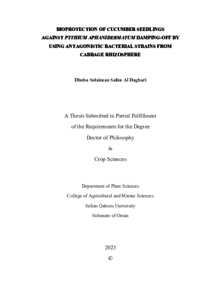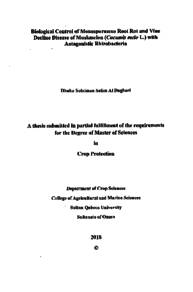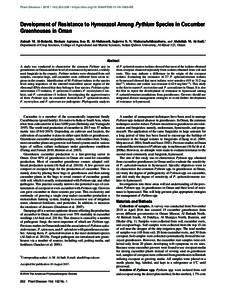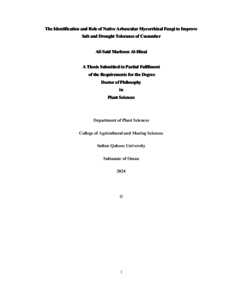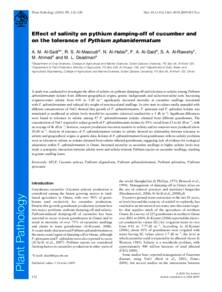Document
Bioprotection of cucumber seedlings against Pythium aphanidermatum damping-off by using antagonistic bacterial strains from cabbage rhizosphere.
Source
Doctoral dissertation
Country
Oman
City
Muscat
Publisher
Sultan Qaboos University
Gregorian
2023
Language
English
Thesis Type
Doctoral dissertation
English abstract
Soil biofumigation is a widely used farming practice for soil-borne disease
management in vegetable crops. Soil biofumigation is the practice of the incorporation
of fresh plant materials from the members of the Brassicaceae family into the soil
which release antimicrobial volatile organic compounds (VOCs), namely
glucosinolates and their hydrolysis products. However, the VOCs may affect nontarget beneficial soil biota including microbial biocontrol agents due to their broadspectrum toxicity. In this study, native antagonistic rhizobacteria were isolated from
cabbage plants grown in biofumigated fields. Their potential in the management of
Pythium aphanidermatum cucumber damping-off was evaluated with and also without
biofumigation using cabbage leaf residue. A total of 20 morphologically distinct,
culturable bacterial strains were recovered from the rhizosphere soil of cabbage
cultivated in a biofumigated field, with the largest fraction of the isolates belonging to
the genus Bacillus. The other bacterial genera isolated were Pseudomonas, Serratia,
Stenotrophomonas, Microbacterium and Priestia. Of the 20 bacterial isolates,
Pseudomonas aeruginosa B1-SQU, Pseudomonas indica B2-SQU, Serratia
marcescens B3-SQU and Pseudomonas brenneri B4-SQU exhibited inhibitory
activity against P. aphanidermatum in a co-culture assay. The deformation and
shrinkage of P. aphanidermatum hyphae due to diffusible antimicrobial compounds
from these bacterial strains were documented with scanning electron microscopy. A
biofilm was formed by these bacterial strains in vitro and they exhibited compatibility
with each other. These bacterial strains significantly reduced damping-off in cucumber
under greenhouse conditions when applied to soil singly, but failed to show a
significant effect when combined with the biofumigation treatment, though the
bacterial population in the soil was maintained at higher levels. They also had no
significant plant growth promotion effect on cucumber. Soil biofumigation alone was
also not effective in suppressing the damping-off of cucumber. Gas chromatography–
mass spectrometry (GC-MS) analysis revealed that 1-butanol, n-butyl butyrate and
butyl acetate were the predominant VOC in the soil amended with cabbage leaf
residue. The results suggest that soil biofumigation with cabbage leaf residue has no
significant effect on P. aphanidermatum under high inoculum levels; furthermore, it
affects the efficiency of the bacterial antagonists in controlling damping-off in
cucumber.
The results of the two-sealed-base-plates assay revealed that all four bacterial
strains produced VOCs against P. aphanidermatum with the maximum inhibition from
P. brenneri B4-SQU followed by S. marcescens B3-SQU, P. aeruginosa B1-SQU and
P. indica B2-SQU. A total of 20 VOCs were detected in P. aeruginosa B1-SQU and
the major compounds identified were Carbon dioxide, 1-Butanol, 3-methyl- and
Disulfide, dimethyl. The main volatile compounds detected in P. indica B2-SQU were
1-Butanol, 3-methyl-, Disulfide, dimethyl and 1,2-Propanediamine. Disulfide,
dimethyl and 1,2-Propanediamine were the predominant compounds identified in S.
marcescens B3-SQU among others. The major compounds detected in P. brenneri B4-
SQU were 1-Butanol, 3-methyl-, 1,2-Propanediamine and Disulfide, dimethyl.
Dimethyl disulfide, a well-known antimicrobial compound, was detected in the
volatile profiles of all four antagonistic bacterial isolates.
The effect of secondary metabolites produced by these antagonistic bacterial
strains on P. aphanidermatum was also assessed. The results obtained from the in vitro
agar well diffusion assay indicated that the secondary metabolites derived from P.
brenneri B4-SQU displayed the highest level of inhibition (85%) of the growth of P.
aphanidermatum. In contrast, the other bacterial strains exhibited comparatively lower
levels (less than 10%) of inhibitory activity. Pentadecanoic acid, 14-methyl-, methyl
ester, was identified as a major compound exclusively in the ethyl acetate extract of P.
brenneri B4-SQU culture filtrate. These results suggest that VOCs and secondary
metabolites of antagonistic bacteria may be involved in the suppression of P.
aphanidermatum.
Category
Theses and Dissertations

